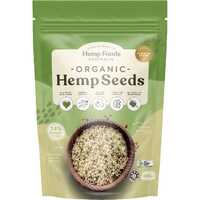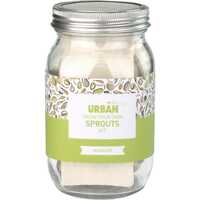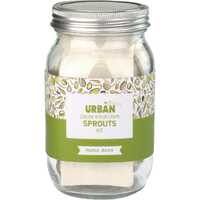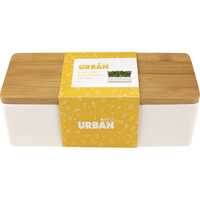In the field of nutrition, sprouting is the natural process that takes place when seeds germinate. A wide variety of seeds can be sprouted and consumed to boost health, including alfalfa, mung beans, sunflower seeds, and more. From bean sprouts to common cereals, legumes, and vegetables, sprouting is a natural process that brings common seeds back to life. Sprouts can be eaten raw or cooked, and they make a great addition to salads, stir fries, and smoothies.
Pre-made sprouts are readily available in supermarkets and health food stores, and sprouting is easy to perform at home with a simple kit. Let's take a look at the wonderful world of sprouts, including their nutritional benefits and many different types.
What are Sprouts?
Sprouting is an essential part of the natural life cycle. In scientific terms, sprouting refers to either the germination of seeds or the growth of existing plants. In the world of nutrition, sprouting happens when seeds "come alive" and produce new shoots. These shoots are known as sprouts, and they offer a variety of health benefits. The germination process itself takes just a few days, and it's easy to perform at home with basic equipment.
Sprouting is a common process used in many long-established global cuisines. Bean sprouts are particularly common, with mung beans, soybeans, and similar products widely used by Asian cultures. Other popular examples include lentils, chia, radish, mustard, buckwheat, kale, and chickpeas. While all viable seeds can be sprouted, some sprouts should be cooked or avoided altogether, including eggplant, potatoes, peppers, rhubarb, and tomato.
Fermenting vs Sprouting vs Activation
Sprouting is often linked with fermentation and activation, with these two ancient practices having regained popularity over recent decades. However, while fermentation and activation both apply moisture and alter temperature, no sprouting actually occurs.
- Fermenting is a metabolic process where starches or sugars are converted into alcohol or organic acids. During this process, bacteria and other microorganisms partially digest foods. Fermenting is an ancient technique that was probably invented to preserve foods, but it also offers health benefits linked with bioavailability and digestion.
- Activating nuts and other foods is a powerful process that has become popular over recent years. Activation is about soaking foods in salted water before draining and dehydrating them at very low temperatures. This process also aids with digestion, as it helps to break down phytates, polyphenols, and other harsh acids. Activation stimulates early germination without visible sprouting.
- Sprouting takes activation further, with the germination process needing to actually begin. Sprouted foods have activated so much that they've sprung back to life. This provides a number of benefits, with phytic acid and other digestive barriers removed and the overall nutritional composition of seeds improved. In most cases, sprouted foods boost the vitamin, mineral, antioxidant, and protein count.
A Short History of Sprouting
While it seems like an exciting new health trend, immersing food in water has taken place over many centuries. Our ancestors regularly soaked or fermented grains before making them into breads, porridge, and casseroles. This practice took place across the world, and before industrial times, it was incredibly common. Rice and lentils were fermented in India, corn was fermented in Africa, and rice was soaked in many Asian and South American nations.
The ancient Chinese are given credit for discovering the value of sprouted seeds, with legumes and other foods germinated many centuries ago. Sprouting was probably performed for the sake of food preservation, with improved nutrition offering a secondary benefit slowly realised over time. Sprouting was used extensively in ancient Middle Eastern and European cuisines, and sprouted grain bread was even mentioned in the Old Testament.
Nutritional Benefits of Sprouts
Sprouted foods offer a variety of health benefits. While nutritional profiles depend on specific foods, the sprouting process itself does have an important influence. Many of these benefits are linked to digestion, with sprouting amplifying beneficial compounds while making nutrients easier to digest.
The following benefits are among the most noteworthy:
Makes foods easier to digest
The process of sprouting makes certain foods digestible without needing to cook them. Foods like legumes and grains, which normally require cooking, can easily be added to salads, sandwiches, and other cold dishes. This increases healthy food intake and makes proteins, carbohydrates, and other nutrients easier to digest.
Boosts nutrients
Sprouted seeds and vegetables often have a richer nutritional profile than non-sprouted versions. While sprouting doesn't change the base nutritional profile of plants, it does help to release beneficial compounds. Profiles vary between foods, but you can expect higher concentrations of vitamin B, vitamin C, and antioxidants. In addition, many sprouted foods have increased levels of folate, magnesium, phosphorus, and vitamin K.
Removes phytic acid
Along with boosting nutrients and improving bioavailability, the sprouting process helps to reduce phytic acids. These compounds are often called anti-nutrients, as they make it harder for your body to absorb the good stuff. We don't have the enzymes needed to break down phytates alone, and the sprouting process helps to make minerals like zinc, iron, and magnesium more readily available.
Different Types of Sprouts
As an essential part of the life process, all seeds can be sprouted. Everything from chickpeas to millet to radish and broccoli can be sprouted under the right conditions, although some foods sprout much more successfully than others. Not all foods produce great results, and some can be outright dangerous. Chia seeds and flax seeds can be difficult to sprout, kidney beans contain a toxin that causes nausea, and quinoa can produce a strong allergic reaction in some people.
The following foods represent some of the safest and most popular sprouting options:
Alfalfa
When you mention sprouts, alfalfa immediately comes to mind. This popular variety has a fresh and mild taste, which makes it a great addition to salads and warm savoury dishes. When eaten raw, alfalfa is a fantastic source of minerals, including calcium, magnesium, and potassium. If you want to sprout alfalfa at home, the seeds take three to seven days to reach their full flavour and size potential.
Broccoli
Like many other examples, broccoli sprouts don't actually taste like broccoli. Instead, they have a nutty flavour that adds a delicious spicy boost to any dish. These sprouts are high in antioxidants, and they're also a good source of fibre, folic acid, and vitamins A, C, and K. Broccoli sprouts take shape after five days, and their striking green colour makes them look great in salads and stir fries.
Chickpeas
Chickpeas can be difficult to digest, and sprouting helps to unlock the nutrients inside. These sprouts are great in fresh salads and tasty soups, and they also make delicious raw hummus. Chickpea sprouts are full of protein and packed with nutrients like iron and vitamin C. Chickpeas spring back to life in just two days, but they may require extended soaking time and more frequent rinsing.
Mung beans
From their ancient origins in Asia to renewed global appreciation, mung beans seem to be getting more popular all the time. Mung bean sprouts have a delicious nutty flavour, and they taste great with salads, stir fries, and contemporary fusion dishes. These sprouts are high in protein, low in calories, and rich in iron and calcium. Mung bean sprouts take three to four days to reach their full-flavoured size.
Radish
Radish sprouts come in many varieties, and somewhat uniquely, they taste quite similar to mature radishes. These sprouts work great in salads and sandwiches, and they're also very tasty in sushi and tofu dishes. Radish sprouts are rich in vitamins B and C, along with minerals like folate and manganese. It takes three to six days to produce sprouts from radish seeds.
Mustard
Mustard sprouts look rather similar to alfalfa sprouts, and they also enjoy a similar nutty flavour. They are much earthier and spicier, however, with a taste that's quite similar to horseradish. Mustard seeds add a nutritional boost of vitamins and minerals, including calcium, iron, zinc, magnesium, and selenium. These sprouts are ready to harvest in three to six days.
Sunflower
Sunflower sprouts have a familiar fresh and nutty taste. These sprouts have a unique texture, however, with a larger size grain giving them a much crunchier quality than other foods on this list. Sunflower sprouts have lots of vitamin D, calcium, and iron, and they take a little longer to sprout at 12 to 14 days.
If you're looking for natural seeds and fun sprouting kits, Healthy Being has everything you need. With thousands of products at heavily discounted prices, it's easier than ever to add the nutritional goodness of natural and organic whole foods to your diet. Shop now and enjoy free shipping options across Australia and worldwide delivery!


 Certified Organic
Certified Organic Vegan Friendly
Vegan Friendly  Vegetarian
Vegetarian Organic Ingredients
Organic Ingredients Dairy Free
Dairy Free Gluten Free
Gluten Free Keto Friendly
Keto Friendly
































